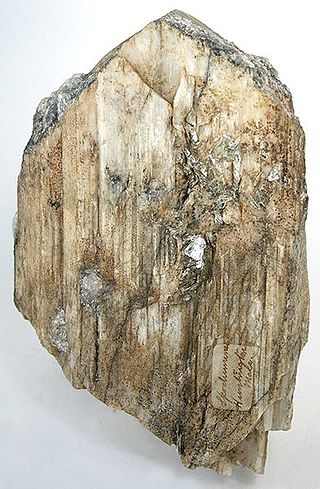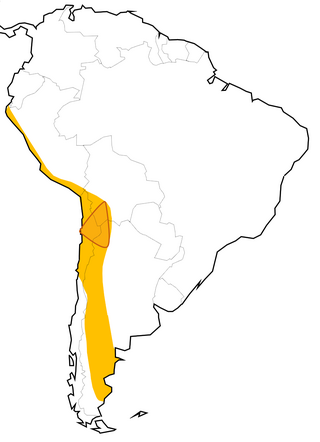Related Research Articles

Lithium carbonate is an inorganic compound, the lithium salt of carbonic acid with the formula Li
2CO
3. This white salt is widely used in processing metal oxides. It is on the World Health Organization's List of Essential Medicines for its efficacy in the treatment of mood disorders such as bipolar disorder.

Gaston County is a county in the U.S. state of North Carolina. As of the 2020 census, the population was 227,943. The county seat is Gastonia. Dallas served as the original county seat from 1846 until 1911.

Humboldt County is a county in the U.S. state of Nevada. As of the 2020 Census, the population was 17,285. It is a largely rural county that is sparsely populated with the only major city being Winnemucca which has a population of 8,431. Humboldt County comprises the Winnemucca, NV Micropolitan Statistical Area and serves as an important crossroads in the national transportation network. Interstate 80 travels through the southeastern corner of the county, meeting US 95 in Winnemucca that serves as a primary freight corridor between Northern Nevada and Boise, Idaho and the Interstate 84 freight corridor that links much of the Pacific Northwest. The original transcontinental railway, constructed by the Central Pacific Railroad, reached Humboldt County on September 16, 1868. The Western Pacific Railroad would reach Humboldt County by November 1909, providing two mainline rail links to California and the Eastern United States. Both railroads have since been acquired by the Union Pacific Railroad, who continues to serve the region today.

Spodumene is a pyroxene mineral consisting of lithium aluminium inosilicate, LiAl(SiO3)2, and is a commercially important source of lithium. It occurs as colorless to yellowish, purplish, or lilac kunzite (see below), yellowish-green or emerald-green hiddenite, prismatic crystals, often of great size. Single crystals of 14.3 m (47 ft) in size are reported from the Black Hills of South Dakota, United States.

Misenheimer is an incorporated village in Stanly County, North Carolina, United States. It is in the southern Piedmont region of North Carolina, near the city of Richfield. The population was 728 as of the 2010 Census.
Glencore plc is a Swiss multinational commodity trading and mining company with headquarters in Baar, Switzerland. Glencore's oil and gas head office is in London and its registered office is in Saint Helier, Jersey. The current company was created through a merger of Glencore with Xstrata on 2 May 2013. As of 2015, it ranked tenth in the Fortune Global 500 list of the world's largest companies. In the 2020 Forbes Global 2000, Glencore International was ranked as the 484th-largest public company in the world. As of July 2022, it was the world's largest commodity trader. In 2023, the company was ranked 59th in the Forbes Global 2000.

OceanaGold Corporation (OceanaGold) is a gold mining and exploration company based in Vancouver, Canada and Brisbane, Australia.
Lithium Corporation of America was a mining company which mined lithium-bearing spodumene and pegmatite ores near Bessemer City, Gaston County, North Carolina, United States and in the Black Hills of South Dakota.
The rare earth industry in China is a large industry. Rare earths are a group of elements on the periodic table with similar properties. Rare earth metals are used to manufacture everything from electric vehicles (EVs), wind turbines, consumer electronics and other clean energy technologies. The rare earths cause improved system performance when for example electric battery terminal LiMn2O4 cathodes are doped with them, and it is known that some EVs use lithium-ion batteries such as these. Tesla automobiles "currently uses an lithium-nickel-cobalt-aluminum (NCA) chemistry, while lithium-nickel-manganese-cobalt (NMC) chemistries are common across the rest of the EV industry." Vehicle "manufacturers are keen to reduce reliance on rare earths, which like cobalt, suffers from highly concentrated supply and unpredictable pricing, with China holding a virtual global monopoly in primary supply and processing." Leading battery manufacturer Samsung SDI uses this technology for its phone and portable computer batteries.
Embreeville is an unincorporated community and census-designated place in southern Washington County, Tennessee. It is located along the Nolichucky River and on State Routes 81 and 107.
The Thacker Pass Lithium Mine is a lithium clay mining development project in Humboldt County, Nevada, which is the largest known lithium deposit in the US and one of the largest in the world. There has been significant exploration of Thacker Pass since 2007. The Bureau of Land Management issued a Record of Decision approving development of the mine in January 2021. Construction began in March 2023 after an emergency appeal was denied by the court. The project site would cover 18,000 acres (7,300 ha), with less than 6,000 acres (2,400 ha) of that being mined, on a site 21 miles (34 km) west-northwest of Orovada, Nevada within the McDermitt Caldera. The mine is a project of Lithium Nevada, LLC, a wholly owned subsidiary of Lithium Americas Corp. In late January 2023, car giant General Motors announced it would invest $650M in the mine project, giving GM exclusive access to the first phase of production. In February 2023, when the initial $320 million investment was completed, GM became Lithium Americas largest shareholder and offtake partner. At full capacity the mine would produce 66,000 tons annually, equivalent to 25% of the current (2021) demand for lithium globally, which is expected to triple over the next five years. Development of the mine is driven by increasing demand for lithium used in electric vehicle batteries and grid storage of intermittently generated electricity from sources such as solar power or wind power.
Galaxy Resources Limited was an Australian public mining company. It was listed on the Australian Securities Exchange until it merged with fellow lithium producer Orocobre in August 2021 to form Allkem.
In 2015, 27.6 million metric tons of marketable phosphate rock, or phosphorite, was mined in the United States, making the US the world's third-largest producer, after China and Morocco. The phosphate mining industry employed 2,200 people. The value of phosphate rock mined was US$2.2 billion.

Australia has one of the biggest lithium reserves and is the biggest producer of lithium by weight, with most of its production coming from mines in Western Australia. Most Australian lithium is produced from hard-rock spodumene, in contrast to other major producers like Argentina, Chile and China, which produce it mainly from salt lakes.

The Lithium Triangle is a region of the Andes that is rich in lithium reserves, encompassed by the borders of Argentina, Bolivia, and Chile. The lithium in the triangle is concentrated in various salt pans that exist along the Atacama Desert and neighboring arid areas. The largest areas three main salt pans that define its vertices are the Salar de Uyuni in Bolivia, Salar de Atacama in Chile, and Salar del Hombre Muerto in Argentina. Of these, the Salar de Atacama in Chile has the highest concentration of lithium among all world's brine sources. The shape of the area of interest for lithium resources in salt pans is however not a triangle but more of a crescent starting with Salar de Surire in the north and ending with Salar de Maricunga in the south. Because of this it has been proposed to rename the area Lithium Crescent.

The Harding Pegmatite Mine is a former adit mine that extracted lithium, tantalum, and beryllium from a Precambrian pegmatite sill. It ceased operations in 1958 and its owner, Arthur Montgomery, donated it to the University of New Mexico, which runs the site as an outdoor geology laboratory with mineral collecting permitted on a small scale.
Ganfeng Lithium Co., Ltd. is a company that produces lithium, lithium products, other metals, and batteries in mainland China and globally. It was founded by Li Liangbin in 2000 and is headquartered in Xinyu, Jiangxi. It is the largest lithium salt producer in China and the third largest in the world, as well as the second largest lithium processor in the world. It is traded on both the Shenzhen Stock Exchange and the Hong Kong Stock Exchange and has a market capitalization of US$26 billion.
The Big Sandy lithium project or Big Sandy lithium mine is a planned lithium mining project located near the Hualapai tribe's Cholla Canyon Ranch and the Cofer Hot Springs, near Wikieup in the Big Sandy River Valley, Arizona, U.S.

Electra Battery Materials Corporation is a Canadian multinational corporation engaged in mining and refining raw materials for electric batteries. Electra owns and operates the first fully permitted metallurgical refinery in North America for producing battery-grade cobalt and nickel sulfate. The company also owns the Iron Creek cobalt-copper deposit in Lemhi County, Idaho, US.
Lithium Valley is an area adjacent to the Salton Sea in Southern California, United States, with enormous deposits of lithium. Due to increased demand for lithium, which is crucial component for batteries used for electric cars and energy storage, the area is attracting attention, and the extraction of lithium is expected to boost the economy of Imperial County. The area is exceptionally well-suited due to the ability to mine the lithium while generating geothermal power. There are already 11 geothermal power plants utilizing the Salton Sea Geothermal Field.
References
- 1 2 3 4 5 6 Scheyder, Ernest (April 15, 2024). "Tesla supplier Piedmont Lithium gets key North Carolina mining permit". Reuters. Retrieved April 16, 2024.
- 1 2 PIEDMONT LITHIUM INC. FORM 10-KT (Report). Securities and Exchange Commission. February 28, 2022. pp. 5–6. 001-38427. Retrieved November 15, 2023.
- 1 2 3 4 5 6 7 8 9 10 11 12 "Piedmont Lithium reports first profit, but still needs money and permits to build Gaston mine". WUNC. November 7, 2023. Retrieved April 30, 2024.
- ↑ Patterson, Scott (March 9, 2021). ttery-powered-car-hopes-ride-on-lithium-one-producer-paves-the-way-11615311932 "America's Battery-Powered Car Hopes Ride on Lithium. One Producer Paves the Way". Wall Street Journal. Retrieved April 30, 2024.
{{cite web}}: Check|url=value (help) - 1 2 3 4 5 6 7 Sorg, Lisa (August 18, 2023). "Piedmont Lithium gets cold shoulder in Gaston County • NC Newsline". NC Newsline. Retrieved April 30, 2024.
- 1 2 3 4 5 6 Patterson, Scott; Ramkumar, Amrith (March 9, 2021). "America's Battery-Powered Car Hopes Ride on Lithium. One Producer Paves the Way". Wall Street Journal . Archived from the original on March 12, 2021. Retrieved March 13, 2021.
- 1 2 3 4 5 "Residents and commissioners remain unhappy with proposed Piedmont Lithium mine project". wcnc.com. August 9, 2023. Retrieved April 30, 2024.
- 1 2 Scheyder, Ernest (June 22, 2022). "Piedmont Lithium Looks Abroad amid North Carlina Uncertanty". Reuters. Retrieved April 20, 2024.
- ↑ Penn, Ivan; Lipton, Eric; Angotti-Jones, Gabriella (May 6, 2021). "The Lithium Gold Rush: Inside the Race to Power Electric Vehicles". The New York Times. ISSN 0362-4331 . Retrieved April 30, 2024.
- 1 2 3 "Mining for the Climate on Apple Podcasts". Apple Podcasts. February 5, 2024. Retrieved April 30, 2024.
- ↑ "'Sorry for my frankness, but let's get to it' | Emails detail growing frustration between Gaston County commissioners, Piedmont Lithium". wcnc.com. February 7, 2022. Retrieved April 30, 2024.
- ↑ Jamasmie, Cecilia (September 28, 2020). "Piedmont Lithium stock soars on confirmed Tesla deal". mining.com. Retrieved March 13, 2021.
- ↑ Piedmont Lithium Signs Sales Agreement with Tesla, 28 September 2020, retrieved 14 March 2021.
- 1 2 Smith, Rich (March 1, 2021). "Why Lithium Americas, Piedmont Lithium, and MP Materials Stocks Popped Today". Motley Fool . Archived from the original on March 4, 2021. Retrieved March 13, 2021.
- ↑ "Piedmont Lithium: Results of First Court Hearing". nasdaq.com. March 2, 2021. Retrieved March 13, 2021.
- ↑ "Piedmont Lithium Announces Results Of Scheme Meeting". Business Wire. April 29, 2021. Retrieved May 1, 2021.